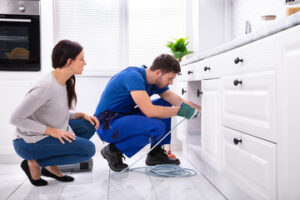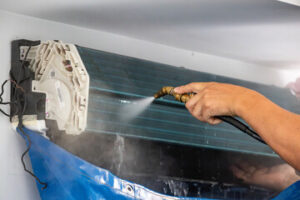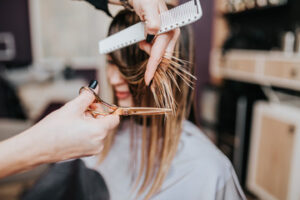Car Detailing is the process of improving or restoring a vehicle’s finish. This can include repairing minor scratches and dents to make your car look as good as new.
It also includes protecting the exterior against damage from UV rays, road grime, saltwater, and natural toxins. Keeping your car properly detailed will prevent premature deterioration and increase its resale value.
Washing

A detailer gently cleans a car by hand with special brushes and tools, often with water-based cleaners that won’t harm delicate materials. Many details also include a steam cleaning and shampooing of the interior, including doors, seats, dashboards, trunk, and other surfaces. Some even include leather conditioning and sanitization.
Some detailers also “clay” the surface of a vehicle, a low-tech yet highly effective method of removing dirt in which a lump of detailing clay is pressed and rubbed across the paintwork to loosen up contaminants that cling to a car’s finish. Other processes a detailer may use to improve the appearance of a vehicle’s paint include wet-sanding, compounding and polishing.
Many new detailers start out by setting packages and pricing for the services they want to offer. But once they get a taste of the business, most realize that every car is different and requires an unique approach.
For example, a car that has suffered swirl marks from improper wash technique will require more time and care than a car that is simply dirty. In addition, a detailer may need to decontaminate the vehicle’s surfaces to make sure they are smooth and free of bound contaminants such as tar and iron fallout.
When washing a car, it is important to move the mitt or towel in straight lines or a Z-pattern rather than circles. Circles can introduce super-fine scratches that are difficult to fix, while straight lines will leave them less noticeable. A good detailer will also use a special brush to clean the crevices of wheels, suspension and other hard-to-reach spots.
It is also a good idea to only use mild detergents and avoid anything that will contaminate the clear coat. Most detailers also recommend rinsing a vehicle immediately after washing to prevent soap residue from drying and potentially scratching the paint surface. Finally, when wiping down a car, a detailer will typically use microfiber towels. These are softer than traditional terry cloth and help to eliminate swirl marks by not leaving streaks or scratches. They also soak up water quickly, which means they can be used multiple times before needing to be washed again.
Claying
Claying removes foreign elements stuck to a vehicle’s paint surface. This is a very important step in maintaining the value and appearance of a car. These elements can include metal or fiberglass that have protruded into the clear coat surface of a paint job. A clay bar looks similar to the sort of play dough a child would use, but is much more elastic. When rubbed across the paint, it picks up a variety of contaminants that could otherwise cause major damage during a car wash or polishing process. It is also an excellent way to remove tar spots and sap residue.
While not every car needs to be clayed, many do. The best way to determine if a car needs to be clayed is to perform a hand test. Using a clean, dry plastic bag, rub your hands over the surface of the paint. If your fingers feel rough, it’s time to clay the car. A few other ways to check for the need of a clay bar include using a water-based lubricant, like a detailing spray or designated clay lube product, to reduce friction and prevent scratching.
The claying process is done after the car has been washed and chemically decontaminated. A quality detailing clay is a soft, malleable product that can be molded by hand to the shape of a panel on the paintwork. A quality clay bar should be lubricated with a water-based product, such as a detail spray or quick detailer, to reduce friction and allow it to glide smoothly over the surface of the paint.
It is important to note that a clay bar can sometimes inflict microscopic damage to the clear coat of the vehicle, but this is usually corrected during machine polishing at a later stage. This is a good reason why most PRO detailers recommend that claying be done in conjunction with paint correction.
Once the clay is lubricated and placed over a panel, the detailer will work it back and forth in short, straight lines, overlapping each other. The contaminant particles will be encapsulated within the clay and can then be easily wiped away with a microfiber towel. This procedure should take only a few minutes to complete.
Polishing
A detailer will then use a polishing machine to refine the paintwork to a smooth, mirror finish. This is a key stage in car detailing and helps to hide blemishes from the naked eye. The process involves buffing off the car polish, wiping away any residue and then inspecting the finish under a variety of lighting conditions. If any scratches or etchings are observed, these will need to be repaired professionally by a bodywork specialist.
The process of polishing the car can take a few hours for a basic interior and exterior clean, but if you have selected the most comprehensive package, then this can take up to a day or more. The amount of time spent will largely depend on the level of detail that you have chosen, as well as the amount of work that is required to restore the vehicle.
It is important that the car is clean before using a polisher, as the smallest dust particle can cause damage if it is dragged across the surface. This is why a pre-wash is so important to remove the vast majority of contaminants.
Before starting the polishing process, it is recommended that you select a high-quality polishing pad and an appropriate level of polish. You should also make sure that you have a high-quality microfiber towel on hand to wipe off any excess polish as it is applied. It is also advisable to choose a quality car wax for your finish.
The most common type of polishing machine is a rotary, which can be very effective when used correctly. However, they are often misused, giving them a bad reputation as dangerous, fire breathing monsters that will burn your paint in an instant. If you spend some time practising with a rotary polisher and reading up on the technique, then this can be an extremely powerful tool in your arsenal.
If you are looking to set up your own business as a professional detailer, then it is worth investing in a good app that will help you manage your customer database, prices, estimates and branded invoices. Many detailers now use a business management app like Mobile Tech RX, which is free to try for a month and can be very helpful when you are just getting started.
Waxing
The final step in car detailing is applying a layer of wax to protect the newly polished and buffed surface. A professional detailer will use an electric or battery-powered buffer to apply the wax, working in small circular motions across the surface. A quality wax will help to eliminate the fine scratches and swirl marks that may have been left behind by the buffer, resulting in a smooth and reflective finish. After applying the wax, the detailer will buff it out with a clean microfibre cloth to produce a glossy shine that is resistant to smudges and water spots.
The importance of car detailing cannot be overstated. The exterior of a vehicle takes a beating from the elements, and over time can develop pitting and oxidation that can diminish its value. The interior of a vehicle is also subject to wear and tear, and can become dirty from food spills or pet hair. Car detailing provides a comprehensive cleaning of all surfaces inside and out, including the trunk and cargo area.
During the detailing process, the car is washed and vacuumed, with special attention given to the wheel wells and undercarriage. A degreaser is often used to remove oil, grease and other contaminants from the engine bay and undercarriage of the car.
A detailed car will be sprayed with a chemical sealant to provide an extra layer of protection against the elements. Many detailing shops will offer maintenance packages to ensure that the fresh, detailed look lasts as long as possible.
While it is tempting to offer set package prices, it is best to implement variable-based pricing to maximize profits. This will allow you to accommodate customers with a variety of car conditions. It will also help you avoid over-charging customers who aren’t willing to pay for your services.
A detailer’s job is not easy, and requires a high level of skill and knowledge of automobiles. They must be able to understand the way light will reflect off of different parts of a vehicle, and work with the different levels of paint thickness on various areas of the car. This is particularly important when dealing with curved panels and sharp creases.








